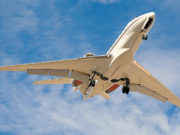Reports
NextGen Air Transportation System: FAA Has Made Some Progress in Midterm Implementation, but Ongoing Challenges Limit Expected Benefits.
U.S. Government Accountability Office (GAO). GAO-13-264. April 2013. 71 pp. Appendixes, figures, tables.
This report, written at the request of members of the U.S. House of Representatives Committee on Transportation and Infrastructure, examines challenges facing the U.S. Federal Aviation Administration (FAA) in its implementation of the Next Generation Air Transportation System (NextGen).
NextGen — an overhaul of air traffic control procedures featuring satellite-based surveillance, performance-based navigation (PBN) and data link communications — is intended to enhance safety in the National Airspace System, reduce delays, save fuel and lower carbon dioxide emissions.
During the “midterm” of the NextGen implementation process, from 2013 through 2018, the FAA’s efforts are focusing on establishing PBN procedures at key airports, using currently available technologies in the hope that some of the benefits of NextGen can be realized now.
“To deliver benefits more quickly, FAA made tradeoffs in selecting sites and in the scope of proposed improvements,” the GAO report said. “For example, FAA is not implementing procedures that will trigger lengthy environmental reviews. These tradeoffs … will likely limit benefits from these PBN initiatives early in the midterm.
“FAA also has made some progress in other key operational improvement areas, such as upgrading traffic management systems and revising standards to improve aircraft flow in congested airspace. However, FAA has not fully integrated implementation of all of its operational improvement efforts at airports. Because of the interdependency of improvements, their limited integration also could limit benefits in the midterm.”
The report noted that the FAA is proceeding with NextGen implementation by using “long-established processes and requirements … that have made the U.S. airspace among the safest in the world.” Nevertheless, because some of those processes are lengthy and complicated, progress toward implementation has been slow, the report said.
The process of developing PBN and other new flight procedures was identified several years ago as a challenge, and the FAA has since begun streamlining the procedures. There is no estimate of how much time will be saved, however.
The report said the agency is developing NextGen performance metrics, but data that would demonstrate its progress are limited.
“Information is incomplete on the midterm improvements and their benefits at selected airports, and airlines and others lack access to needed information to make fully informed investment decisions,” the report said.
The report recommended that the FAA “better integrate NextGen efforts, develop processes for selecting new PBN procedures and ensure that stakeholders have needed information on NextGen progress to facilitate investment decisions.”
A Review of the Effectiveness of Emergency Locator Transmitters in Aviation Accidents
Australian Transport Safety Bureau (ATSB). AR-2012-128. May 2013. 23 pp. Appendix, figures, photographs, table.
Accident investigators and others in the aviation community have for years expressed concern about the effectiveness of airframe-mounted emergency locator transmitters (ELTs), which are designed to activate automatically after a crash. This report discusses the findings of ATSB researchers, who examined the agency’s data and found that ELTs function correctly in 40 to 60 percent of accidents in which their activation would have been expected.
They also reviewed search and rescue (SAR) records maintained by the Australian Maritime Safety Authority and found that ELT activation accounted for the first notification of an accident in about 15 percent of cases. These activations were considered responsible for saving about four lives per year, the report said.
The report found a number of factors that were responsible in accidents in which the ELTs did not function properly. Among those factors were “not selecting the ELT activation to ‘armed’ before flight, incorrect installation, flat [depleted] batteries, lack of waterproofing, lack of fire protection, disconnection of the co-axial antenna cable from the unit during impact, damage and/or removal of the antenna during impact and an aircraft coming to rest inverted after impact.”
The report cited several accidents involving ELT issues, including improper installation, separation of an ELT from the aircraft during the accident, destruction of an ELT by a post-impact fire, and failure of a water-damaged ELT.
The report said that when ELTs are installed correctly, they should operate in high g-force accidents. It suggested the use of ELTs equipped with a global positioning system (GPS) receiver to enhance the accuracy of their position-reporting. Newer ELTs with “3-axis” g switches may improve chances that the unit will activate after impact, the report said.
“It is important to remember that ELTs are an important safety device, not only for aircraft occupants but also for SAR personnel,” the report said. “Even if an aircraft is destroyed in an accident and the occupants are deceased, a functioning ELT helps SAR in minimising search times, risk to rescue personnel and use of SAR resources.”
The report cited data showing that, of 442 SAR operations associated with aircraft emergencies between June 1999 and December 2012, 68 operations “benefited from the detection of an activated ELT or PLB [personal locator beacon], resulting in 52 lives saved during this period.”
Development and Utility of the Front Line Manager’s Quick Reference Guide
DOT/FAA/AM-13/10. McCauley, Darendia; Peterson, L. Sarah; King, S. Janine. U.S. Federal Aviation Administration (FAA) Office of Aerospace Medicine. May 2013. 18 pp. Appendix, tables.
This document was developed to examine the effectiveness of the Front Line Manager’s Quick Reference Guide (QRG), a resource guide to help front line managers (FLMs) in air traffic control operations more effectively supervise their employees while enhancing safety and communication. It also serves as “training support, when other training opportunities may not be readily available,” the document says.
The QRG itself was developed, in part, with input from studies conducted by Booz Allen Hamilton to identify the best practices of FLMs in promoting safety — and therefore to mitigate operational incidents and runway incursions throughout the National Airspace System.
To assess the usefulness of the QRG, the FAA Civil Aerospace Medical Institute and the FAA Air Traffic Organization developed and administered a survey of FLMs. A copy of the survey, which received responses from about 850 individuals, is included as an appendix.
Survey results showed that 82 percent of respondents considered information in the QRG “somewhat or very appropriate to their jobs,” and more than half said they would “probably” or “definitely” use the QRG for reference.
Electronic Media
The FAA maintains this guide for U.S. operators of aircraft in NAT airspace — the most-traveled oceanic airspace in the world, with about 450,000 flights in 2011. The guide, in Adobe portable document format (PDF), “brings together multiple sources of domestic and international regulatory guidance relevant to flight operations in NAT airspace,” the FAA says. “This guide provides operators and FAA inspectors an easy ‘one-stop’ access to multiple sources of information used to promote the highest standards of horizontal and vertical navigation performance and accuracy in the NAT.”
Documents contained in the guide discuss flight planning, weather deviation and strategic lateral offset procedures — procedures that enable flight crews on some aircraft to fly on a track parallel to an airway centerline, 1.0 or 2.0 nm (1.9 or 3.7 km) to the right.
The guide is updated monthly and to provide the most current information for mitigating large height deviations and gross navigation errors in the NAT, the FAA said. A large height deviation is defined as a deviation of 300 ft or more from an assigned altitude/flight level; gross navigation errors are deviations of 25 nm (46 km) or more.

